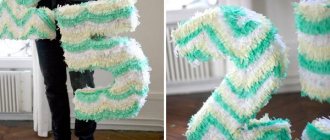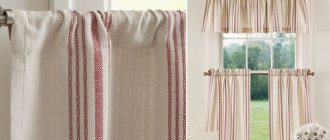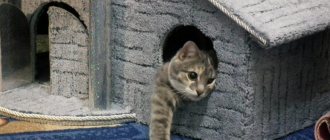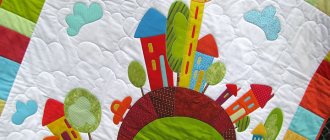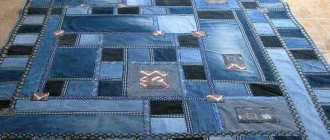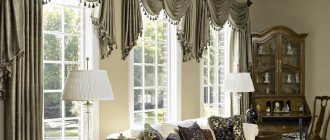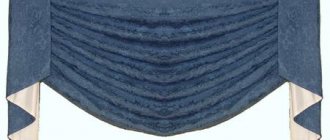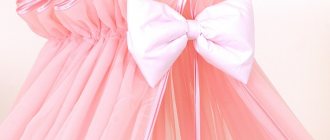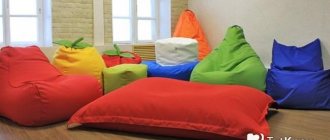This is something everyone thinks about if they want their living room, bedroom or any other room to be unusual in its design.
There are many options for creating draperies on fabrics , but the most popular are folds directly on the canvas, which can be bow, one-sided, glass, and all of them are usually done by hand. Therefore, you need to know the technique of creating them.
Pleated curtain design
The main source of good mood is tastefully designed and sewn products.
But you can create beautiful folds on curtains only if you have high-quality fabric and the correct assembly technique for it.
At first glance, it may seem that there is nothing complicated about this: there is fabric, there are two hands, but on top of everything else you still need desire, skill and a little imagination, without which it is impossible to create anything original.
The density of the fabric, its texture and color scheme dictate what assembly technique can be used in a particular case, and if it is dense but soft material, then volumetric folds such as bows, glasses, and one-sided ones will look great on it. You can learn more about matching the color of curtains to the tone of the wallpaper in this article.
What styles can be mastered without sewing equipment?
There are several stages in sewing curtains, but the most important thing is not to make mistakes in the measurements. It happens that there is a piece of beautiful tulle or a ready-made lambrequin, but it is not enough for a whole window. Or there are curtains from another room that have to be reformatted to fit another window opening. You have to use your imagination and experiment with what you have.
When thinking about how to sew curtains with your own hands from existing fabric, it is important to decide on the style. Japanese curtains do not require special skill - it is important to equip narrow curtains with a movable mechanism purchased from sewing accessories departments.
For smooth screened panels you need a special electrically driven cornice. Any workshop will help you cut off the edges and overlay the edges of the panels.
In a similar way, you can solve the issue with roller blinds. A special lifting mechanism that winds a strip of fabric onto a roller is easy to find in a specialized store - the package includes instructions for assembly and fastening. All that remains is to cut out the suitable fabric and take it to the studio to process the seams.
In some cases, it is not necessary to have sewing skills, but it is good to know how to crochet. A curtain made using the fillet technique, where the pattern is formed by alternating empty and filled windows, will decorate a kitchen or a child’s bedroom window.
Using a crochet hook from leftover yarn, you can make rope or thread curtains yourself, decorating them with beads, pom-poms or tulle balls.
A curtain with wide hinges is the same rectangular panel, processed along the edges by a craftsman from the studio. Loops can be sewn from thick satin ribbon in the color of the fabric at a certain interval. This mount fits directly onto a rounded plastic or metal curtain rod, creating a light wave-like assembly.
There is nothing difficult about how to sew curtains with eyelets with your own hands. These are rings through which a rounded cornice is threaded. To do this, the curtain fabric on top is folded into a wide strip, on which through holes are made for fastenings.
Note! Eyelets come in different sizes and shapes and are made of wood, plastic or metal. You can choose the most suitable version for your cornice, the main thing is that the rod of the cornice passes through the internal holes of the original fastening.
Types and models of folds on curtains
What draping technique should I choose so that it can make the product the most striking in terms of design solutions?
In any case, we should not forget that any curtain will look neat if you correctly and competently calculate the depth of the fold of the fabric.
After all, the greater the number of deep folds used, the larger the footage of fabric required for sewing curtains.
Bow pleat look on curtains
What can you say about this type of fabric draping? Folds can be made along the entire length of the curtains or in single moments, alternating between an even field of fabric.
There are several ways to decorate curtain fabric, depending on which the ratio of fabric to the width of the finished product changes.
The fold width is minimum 2 cm and maximum 8 cm, as a result, one bow element is 4 cm and, respectively, 16 cm.
The most common ratios of the two components are the following variations:
- 1 to 3 , when there are no gaps between the edges of the bow elements, they go one after the other and the edges touch each other. To sew such curtains, you will need fabric 3 times the length of the cornice or the width of the finished lambrequin;
- 1 to 2.5 , in this option the distance between the edges of the folds is smaller compared to the width of the folded fabric. The estimated amount of material for sewing such products should be 2.5 times greater;
- 1 to 2 , with this ratio the width of the bow folds is equal to the distance between them, which means that to make curtains you will need twice as much fabric. This is the most economical option, but also the least voluminous.
The bow fold on curtains is used both for making lambrequins and for curtains of different lengths.
For example, this technique is often used in English-style curtains, where the products on the windows look very elegant.
English curtain models are most suitable for windows in the kitchen and bedroom; in such an environment you feel homely and it’s pleasant to be here.
LiveInternetLiveInternet
-Music
—Categories
- CARS (119)
- East (49)
- EVERYTHING FOR CHILDREN (1118)
- Books (9)
- Drawing (150)
- Learning English (69)
- Knitting (429)
- Cooking (44)
- Fairy tales (46)
- movies (24)
- Sewing. (337)
- EVERYTHING FOR WOMEN (4090)
- Diets (600)
- diets in pictures (39)
- For feet (123)
- For hands (196)
- perfect figure (283)
- How to make soap with your own hands (21)
- pictures - all about color. fashion, about clothes, online (224)
- Books, magazines (14)
- Cosmetics for face and body (619)
- MAKEUP (180)
- HAIRSTYLES (235)
- Psychology, esoterics (332)
- self-education (467)
- Tips (119)
- Hair tips (408)
- TIPS FOR WOMEN (168)
- ALL ABOUT BEAD (1535)
- COSTUME JEWELRY, beading (528)
- Bead embroidery (395)
- Knitting with beads (65)
- Bead tutorial, lessons, wire weaving (159)
- TIPS, BOOKS (264)
- Schemes, websites (93)
- Weaving with beads (32)
- ALL ABOUT STONES About aromatic oils and incense (154)
- Embroidery, patterns (904)
- Carpet equipment (45)
- GUILLOCHINE, RICHELIEU, WOOD BURNING AND TC (71)
- Satin stitch, volumetric embroidery (89)
- Needle Turkish lace, Tatting (99)
- Books and magazines (75)
- Cross stitch (52)
- Ribbons and threads (46)
- For knitwear (21)
- Programs, frameworks (39)
- Websites (10)
- Tips, embroidery on plastic canvas (107)
- Bargello technique, temari (71)
- KNITTING (7925)
- Continuous crochet, Tunisian crochet (88)
- Bruges, Irish, ribbon, Romanian lace (411)
- Bags (195)
- Felting, temari (37)
- knitting + fabric (105)
- knitting patterns from Japanese magazines and translations (200)
- magazines, books (655)
- crochet (962)
- swimwear (132)
- machine (203)
- On the fork (59)
- ON LUM, ( TENERIFE, FRAMEWORK, TEMPLATES) (85)
- Nuking (4)
- shoes (sewn and knitted + patterns) (282)
- Gloves, belts, umbrellas (120)
- Detailed descriptions of models (1)
- useful knitting tips, programs (398)
- Various little things for our pets (272)
- VARIOUS KNITTING TIPS, frames (21)
- Napkins, collars, dishes, blankets (293)
- knitting needles (571)
- tops, tunics (593)
- Transformers (39)
- crochet patterns (857)
- knitting patterns (319)
- Sirloin knitting (57)
- shawls (565)
- hats (319)
- For a pet (106)
- Tips (3)
- weight loss diaries with Igor Obukhovsky (62)
- Galina Grossmann (31)
- Earnings (22)
- HEALTH (3424)
- From Dr. Komarovsky, lectures by OGULOV A. T. (40)
- pictures - food (338)
- about diseases (469)
- Healing music (6)
- traditional medicine (1162)
- Tips (943)
- Points, massage (122)
- Exercises for health (178)
- GAMES (20)
- HOME IDEAS (2829)
- Country ideas (360)
- Interior design (41)
- making boxes (91)
- Living room interior (3)
- kitchen interior (1111)
- Bedroom interior (9)
- furniture (286)
- Useful tips for repairs. (28)
- various little things (46)
- do it yourself (394)
- advice, programs (42)
- COOKING (9264)
- no-bake cakes (120)
- chicken, duck, goose, turkey dishes (583)
- preserves, jams (121)
- Baking (1006)
- GOOD TIPS (328)
- Diet dishes (127)
- Jelly cakes, jelly. (74)
- winter preparations (498)
- Casseroles (136)
- pictures - cooking, frames for recipes (154)
- Fermented milk products (250)
- Books, recipe collections, etc. (64)
- candies (600)
- Ice cream, desserts (227)
- Multicooker, double boiler (recipes) (120)
- meat (282)
- drinks (373)
- First courses (63)
- Cookies (264)
- Pies (343)
- according to GOST as in childhood (50)
- USEFUL TIPS FOR THE HOSTESS (134)
- Proper nutrition (213)
- Cooking various fruit dishes (11)
- Cooking different dishes for the holidays (9)
- Seasonings, gravies, sauces, marinades (203)
- Recipe frames (22)
- Recipes from different countries (141)
- Recipes by chef Hector Jimenez Bravo and others (27)
- fish (613)
- Salads and various main courses (704)
- baking secrets (259)
- Serving and decorating dishes and dinner for your loved one (350)
- Spices (73)
- cakes (361)
- Turkish cuisine (121)
- Note to the hostess (178)
- MY CITY (6)
- MUSIC (205)
- Sacred music (5)
- MOVIES (86)
- EDUCATION (332)
- English language (118)
- Arabic (1)
- pictures – Russian language (11)
- German language (34)
- speech development (20)
- Russian language (24)
- Dictionaries. translators (46)
- Turkish language (2)
- MUST READ. (619)
- Various pictures (27)
- humor, jokes (48)
- DESIGN OF A DIARY, COMPUTER (762)
- pictures (97)
- computer (252)
- laptops, tablets, phones (32)
- design of a diary, book, ZNCYCLOPEDIA (215)
- holidays (25)
- Backgrounds, frames (68)
- WEAVING (377)
- decoupage, decor, tapestry weaving (266)
- newspaper weaving, macrame, kumihimo (95)
- USEFUL TIPS (1077)
- important (136)
- EVERYTHING WILL BE GOOD advice (32)
- stain removal (61)
- ironing (7)
- for washing dishes, sinks, toilets (189)
- using soda, vinegar (161)
- pictures - important tips (38)
- shoes (32)
- washing (96)
- carpet cleaning (33)
- ORTHODOXY (695)
- Making candles with your own hands. (54)
- Prayers (152)
- catering for holidays (109)
- Holidays (152)
- Proverbs. (29)
- Advice., Funeral. (124)
- TRAVEL - VERTAL TOURS ACROSS COUNTRY (238)
- GREECE (4)
- EGYPT (11)
- ISRAEL (11)
- CYPRUS (5)
- CRIMEA (12)
- THAILAND (7)
- Note for tourists (59)
- Türkiye (49)
- UKRAINE (16)
- France (2)
- Switzerland (5)
- miscellaneous (60)
- SIZE CHARTS (30)
- GARDENING (701)
- folk remedies for insects (85)
- Useful plants (212)
- Adviсe. (206)
- TIPS FOR MEN (208)
- Knitting (96)
- Fashion and sewing (105)
- TIPS FOR A BEGINNING PHOTOGRAPHER (173)
- links to websites (68)
- POEMS (57)
- FENG SHUI (974)
- wish map, horoscopes (403)
- Signs - tips (470)
- SEWING (957)
- Patterns, sewing technology, transformers, fashionable products (170)
- Design, modeling of clothing (136)
- Homewear, underwear (underwear and bed linen) (105)
- TIPS, master classes, tables, corsets (85)
- Programs, websites, sewing accessories. (43)
- Fashion (37)
- All about curtains (36)
- Color combinations, stylish clothing sets (33)
- Fashionable wardrobe (7)
- Books and magazines (87)
- Leather and fur products, leather weaving (62)
- Various small items, bags (133)
- Sewing with Timofeev, Koorovitskaya, Paukshte (2583)
Folds on curtains in the form of glasses
The folds of the glasses add soft drapery to the curtains. On medium-density curtains, such decorative elements look quite original.
A distinctive feature of this type of fold on fabric is its semi-cylindrical shape, which is obtained by fixing the folds four times inside one large fold, as well as filling the upper part of the cylinder with artificial filler such as synthetic padding polyester.
It is this method of draping that designers use to create curtains with an interesting decorative theme.
Fabric consumption for different styles
Curtain, from the French word “store”, translates as “fabric curtain”. “Tulle” (a masculine word) is consonant with the city where this light translucent fabric was invented at the textile manufactory.
Each cultural era offered its own style, but the name does not always coincide with the place of origin.
The most common curtain styles:
- French "marquise";
- Austrian curtain (with soft gathers at the bottom and two tiebacks);
- English multi-layer curtains (with folds and fringes, often made of velvet or velor);
- Roman (with uniform folds and a lifting mechanism);
- Italian (narrow long canvases with interceptions in the middle, often used to fill the piers on bay windows);
- Japanese (smooth screened curtains with a weighting material at the bottom edge, require special movable curtain rods with remote control and electric drive).
This is a design classification, it is very conditional, but it makes it easier to determine how complex the tailoring will be. Each type requires its own type of fastening - on a baguette, cornice or ceiling strip with runners.
The fabric pattern is determined by the style and overall design concept. Narrow fabrics are suitable for roller and Japanese curtains.
Today, many single-layer and multi-level curtain compositions, simple and complex styles have been developed. There are single curtains without drapes and multi-layer curtains with draperies, tiebacks and pelmets or color blocks.
Kitchen curtains can be decorated with ruffles and frills, but this is not always appropriate in a strict modern bedroom.
Hand-draped curtains
Any skill should always be highly valued, and handmade even more so. the most popular design direction has gained wide popularity .
This option for draping curtains allows you to modify the interior of the room, giving it special attractiveness and even luxury. Ready-made French curtains create equally beautiful draperies; you can learn more about such curtains here.
There are a huge number of variations on the Internet for creating draperies that are unique and inimitable in their design, which can be made using large or very small hand-made assemblies.
The most original decorated element on curtains is created, as a rule, using the simplest methods.
These can be models of curtains with lambrequins in original assemblies or curtains with tiebacks, with the help of which a beautiful volume of freely hanging fabric is created. You can learn more about the types of curtain tiebacks here.
Required skill level
Awning curtains differ from each other not only in color, method of fastening and static, but also in the shape of scallops (falling folds). For example, if dense and heavy fabric is used for tailoring, the tails will have a rounded appearance and a large degree of sagging. Lightweight and well-kept fabric will help create lush, low-sagging scallops.
It is not difficult to sew this type of window draperies, however, it is better for a novice craftswoman (master) to opt for a static version, which will not rise or fall, but will perform a purely decorative function.
aura_home_com
assem_nurlybayeva
One-sided folds on curtains
One-sided folds are a popular way of decorating interior products ; a very interesting design theme is created on curtains in this way.
This technique of folding fabric includes elements folded in half, the laying of which is performed first on the wrong side, where width and depth markings are applied. Then the work is transferred to the front side.
The direction of bends is carried out in one direction only.
After the folds are laid out in a row, they are fixed using a sewing machine or manually.
Simplified sewing option: step-by-step instructions with photos
The preliminary preparation is completed and you can start sewing French curtains. We offer you step-by-step instructions with photos that will help even an inexperienced craftswoman sew awnings on her own.
- To obtain soft draperies and curves after tightening the braid, darts are made on top along vertical lines. Their size depends on the height of the product. When lengthening the curtain, the dart will be much longer and deeper.
Calculation table for scallops for French curtains - Draping is done using a small drapery braid with rings into which the cords of the lifting device are threaded. The length of such a braid is acquired based on the following parameters: the height of the awning, multiplied by the number of sections, adding the height of the cut.
Advice. For huge windows, it is advisable to make large sections, and for narrow ones, neat small waves (from 0.25 to 0.45 m). The number of sections for windows can be calculated using a special table.
Operating procedure:
- Place the curtain on a smooth surface (for example, the floor) face down.
- Pin the braid along vertical lines with needles so that the bottom of the product coincides with its end.
- On the side, the braid should be placed butt to the side edges.
- Tuck the ends of the braid from below a few centimeters, pulling the cords out of the fold in advance.
Diagram: simplified method of sewing French curtains
- Sew the ribbon to the product, and then iron the bottom of the curtain and stitch the edge at the bottom.
- After the tape is sewn, you need to adjust the top cut to the size of the tape fastener.
- Cover the cut with tape and stitch it.
- Sew small weights on the bottom to maintain the vertical shape of the curtains.
- Pull the cords together to form delicate folds of drapery. They are secured with ribbons.
